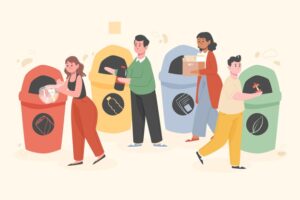
Why should we recycle?
Recycling helps to protect and take care of the environment. When we recycle everyday household items, we save energy, plus we’re reducing the emission of greenhouse gases, as well as decreasing air and water pollution which occurs during raw material processing. By teaching our kids positive recycling habits like not littering or throwing away plastics, bottles, and paper, we’re creating environmentally responsible adults who can have a lasting effect on the world. Being proactive is a win-win. Check out our DomiDocs HomeLock™ video to see how you can proactively protect your family from fraud!
What items can I recycle?
The EPA has identified the following items as the most common recyclables:
- aluminum cans
- batteries
- cardboard
- glass including beverage and food containers
- household hazardous waste, such as paints and pesticides
- newspapers
- mixed paper including gift wrap, gift bags, junk mail, magazines, cereal boxes
- plastics including drink bottles, shampoo, and detergent bottles
- steel cans
- tires
- used motor oil
Pro Tip: If you set up simple recycling bins in high traffic areas within your home, you’ll have a better chance of quickly making recycling a new and fun habit for your family to participate in. After all, you’re helping the earth with everything you recycle, so be proud of your efforts!
Reduce
If you can reduce the number of materials you use every day, you’re in turn reducing the amount of waste being sent to incinerators and landfills. According to The Nature Conservancy, every American generates 4.4 pounds of garbage daily but if you choose to make even small eco-friendly choices, you can have a positive impact on the planet. The Nature Conservancy suggests:
| Reducing the Use of | Substitution Solution |
| single-use beverage containers | reusable cups or water bottles; teach kids to reuse a cup when they want another drink throughout the day |
| one-time-use plastic grocery bags | reusable cloth bags |
| products where packaging is excessive or simply can’t be recycled | look for similar alternatives with recyclable packaging |
| plastic straws | reusable glass/metal straws |
| single-use utensils | keep a set of silverware at work or in your car |
| packaging in general | reusable bags/baskets to shop at bulk food stores and/or farmer’s markets |
| paper | request an e-receipt, and opt-out of mailings that can be accepted digitally; teach kids to draw on both sides of their papers and pages in their notebooks |
Reuse
Besides utilizing reusable water bottles, grocery bags, silverware, and straws, if you reuse a household item, you won’t need to spend money on buying a new one or disposing of an old one. You’ll also be decreasing air, land, and water pollution. When we reuse items, it means the item continues to function as being valuable and useful.
Sometimes all it takes is a little creative adaptation to be able to use a product for another purpose. Some cool reuse ideas include using:
- an old picture frame as a whiteboard (with glass), or a jewelry hanger (without glass) and by adding rows of wires
- a painted packing tube with a split down the side easily tidies up your electrical cords from behind your desk
- pieces of broken terracotta pots as garden markers
- pieces of broken crayons melted together makes a colorful crayon candle
- mismatched earrings or broaches can become beautiful fridge magnets or cabinet pulls
- an old bicycle wheel as a ceiling hanger for pots and pans
Recycle
The EPA identifies three steps in the recycling process which represent the three arrows of the continuous loop recycling symbol 
Step One: Collection and Processing
– items are dropped off at centers or collected curbside
– they’re sent to facilities where they’re sorted, cleaned & processed into raw materials
Step Two: Manufacturing
– recycled materials are used to make newspapers, paper towels, soft drink containers, steel cans, plastic laundry detergent bottles
– recycled glass can be used in asphalt pavings
– recycled plastic can be used in park benches and carpeting
Step Three: Purchasing New Products Made From Recycled Materials
– purchase new products that contain recycled content or can easily be recycled
– common products made from recycled content can include aluminum cans, cereal boxes, egg cartons, glass containers, and trash bags
An added bonus? The recycling industry accounted for 681,000 jobs nationwide in 2016 alone, including $5.5 billion in tax revenue. If you return your bottles and cans for recycling, the money gained can be shared among family members as a reward for their efforts.
Composting
Composting is one of the easiest ways to recycle nearly 25% of the things in your trash including food scraps like coffee grounds and eggshells, along with yard waste such as leaves and grass clippings. This rich organic matter will benefit your garden’s soil so your vegetable crop may produce even better yields. The EPA notes that in 2018, Americans composted almost 22 million tons of yard trimmings, an increase of 500% over that from 1990 so we’re on the right path!
What can you do with items that no longer spark joy?
There are many organizations in your community that will gratefully take your unwanted items such as charitable drop-off centers, thrift stores, and drop & swap stations at your local landfill. Reuse centers are always looking for donations of furniture and building materials.
When you practice recycling, you’re reducing your carbon footprint while being proactive about the future of our planet. DomiDocs also believes the key to safeguarding your home is by proactively monitoring it from deed and title theft with HomeLock™, the most advanced proactive digital property monitoring available on today’s market. Why do I need protection from property fraud? According to the Federal Trade Commission, property fraud increased a whopping 6,134% from 2015-2020 alone. Don’t become a victim, protect your family today with HomeLock™.
Author – Connie Motz



